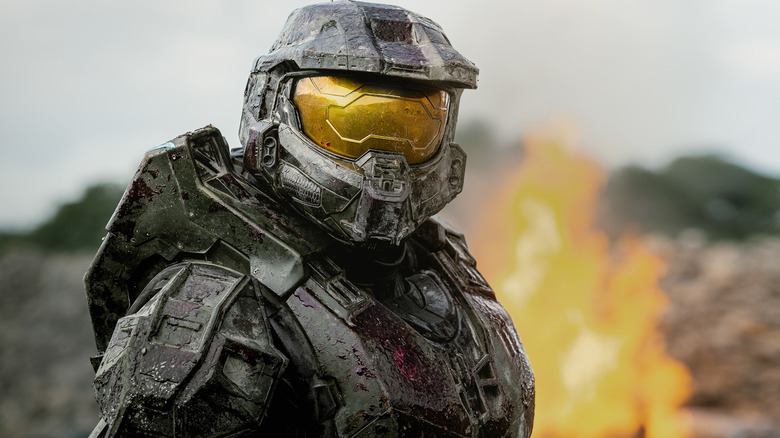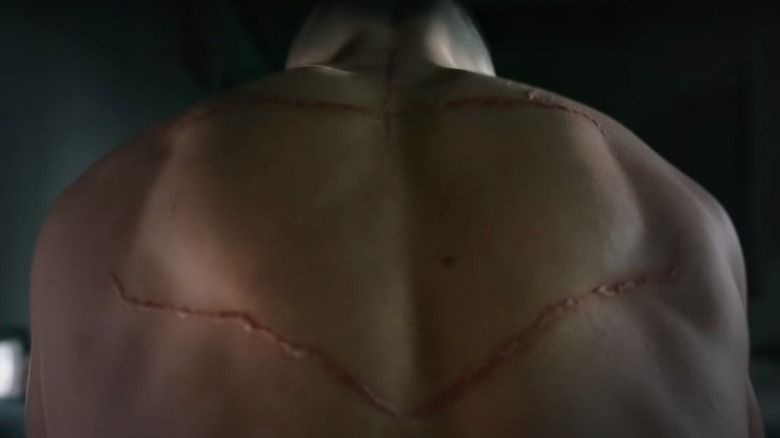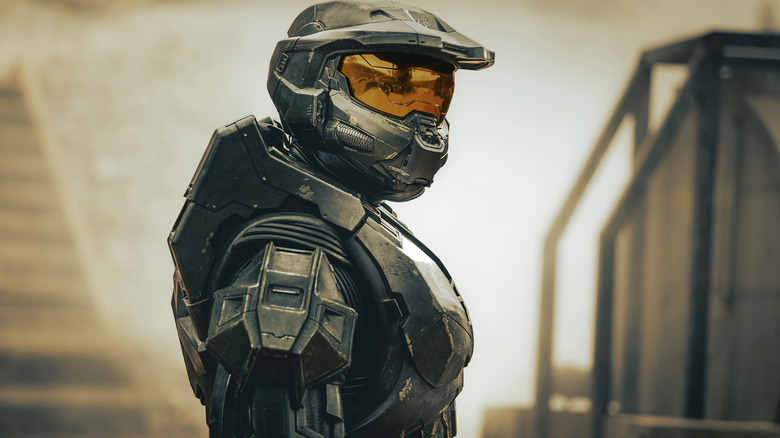Halo Breaks A Major Rule From The Video Games In Episode 1
Beware of spoilers for the first episode of "Halo" below!
What lengths are writers and directors prepared to go in the pursuit of avoiding the fate that has befallen practically every other live-action video game adaptation in decades past? With a property as beloved as "Halo" is, that pressure doubles (if not quadruples) for the creative team in charge of developing the Paramount+ series that, after a long and terribly winding path, has finally arrived on the small screen. Steven Kane and Kyle Killen, the showrunners for season 1, were given the tall task of navigating those treacherous waters and guiding this project to the finish line. With material that inspires passionate fan interest and potential backlash over any perceived recklessness directed towards the all-important canon, the question then became whether to opt for a 100% faithful adaptation of the games (primarily the first one, "Halo: Combat Evolved"), or do their own thing altogether, using all the established backstory, lore, and characters as a jumping-off point to tell brand-new stories fit for a completely different medium.
"Halo" has decisively chosen the latter course of action. The jury is still out on whether this approach will ultimately prove effective, of course, even after the debut of the series premiere that's likely to lead to mixed reactions among diehard fans (you can check out my review of the first 2 episodes here). Of course, nowadays any bold or unexpected creative choice is bound to lead to unending controversy (see: "The Last Jedi"), a possibility that only increases with the always-fervent fandom of the gaming community. Of the many purposeful deviations from established lore, the one destined to stir up the most opinionated debate has to be a decision that directly affects our perception of the main character, the Master Chief John-117.
Even the most casual fan knows that the Master Chief simply never takes off his helmet — on-screen, that is. The sense of mystery has always allowed players of all backgrounds (though sadly not sex, which fellow sci-fi franchise "Mass Effect" would at least take greater strides to address later on) to imagine themselves encased in the Mark VI Mjolnir armor, fighting off hordes of Covenant invaders.
But that helmet finally came off in the "Halo" premiere.
Man or machine?
Over two decades ago, "Combat Evolved" established a grand tradition that would remain steadfastly unbroken ... until now. Throughout the entirety of the game, we only ever see the faceless Master Chief either from within his helmet during gameplay or third-person shots of his imposing armor in various cutscenes, projecting a sense of calm and control as he attempts to survive the harsh and unforgiving ringworld of Halo. We never see John-117's actual face or even learn anything about his actual backstory, allowing us to embody the ultimate player stand-in (one might even call him a "Mary Sue," in a sense!) and truly become immersed in the incredibly world-building of the "Halo" universe. Only at the last possible second, as the camera recedes from the Master Chief and conveniently blocks him from sight, does he finally take off his helmet after a job well done.
For most of the runtime of the first episode of "Halo," titled "Contact," that crucial quality certainly appears to remain intact for this streaming series. Until it doesn't. After rescuing teenager Kwan Ha (Yerin Ha) from the Covenant attack on Madrigal, the Master Chief (portrayed by Pablo Schreiber) is subsequently faced with the toughest decision of his military career while on his way back to reconvene with his superiors. Until now, the episode implies, the Spartan super-soldier has only ever followed orders to the letter, unquestionably and obediently as he and his fellow soldiers were trained to do. It takes the disruptive influence of Kwan and her ever-questioning ways (along with a crucial assist by a mysterious Covenant artifact recovered from Madrigal, which imbues John with visions or memories of a childhood he no longer remembers) to shake the Master Chief out of his programming and remind him that some things do, in fact, matter more than following unethical orders.
His moment of truth comes when he refuses to go along with an "Article 72" command to execute Kwan, an Insurrectionist survivor from Madrigal and a sworn enemy of the UNSC. In order for their unsteady bond to slowly grow into something resembling mutual trust, John does the only thing he can think of — at gunpoint from a (rightfully) suspicious Kwan, he removes his helmet and makes himself completely vulnerable to her. For once, the supposedly un-killable Spartan brings himself down to everyone else's level.
Removing the helmet: the right call or the wrong one?
For as much imaginary internet ire this one creative choice will inevitably lead to social media and elsewhere, the explanation for removing the Master Chief's iconic helmet and letting us actually see the man behind the machine is a very simple and straightforward one. As star Pablo Schreiber said in an interview with /Film recently:
"I always knew that the helmet off was going to be a big part of the show because, just quite frankly, it's the only way to tell this story in long-form television format. The game was made as a first-person shooter, where you're meant to believe that you're the Master Chief. So the character was kept vague for that reason, and you infuse the character with your own personality and your own subtleties. This is a TV show being made for long term success. In order to do that, you have to bring the audience along with you. And really, the only way of doing that is seeing the face, knowing how the character's feeling about things. That's how you empathize with them. That's how you go along with them on the journey.
Schreiber goes on to describe how the question of "Who is the Master Chief?" (a sentiment echoed elsewhere by the "Halo" showrunners) ends up becoming the driving force behind the series, calling the unmasking moment "a necessary thing" for viewers to get used to. Between the show's attempt to humanize John and tell as effective a story as possible that truly takes advantage of the medium of television, the answer is abundantly clear: the creatives almost had no choice but to take the hero's helmet off. The fact that it came at such a crucial, story-defining moment only lends further credence to the divisive and relatively risky decision.
In many ways, the premiere episode of "Halo" serves as a statement of intent. This isn't the direct adaptation of "Combat Evolved" (or the story leading up to the original game) that we may have expected. The question of whether that turns out to be the most effective way to have told this new story? We'll just have to wait for the entire season to play out.
New episodes of "Halo" will stream on Paramount+ every Friday.


